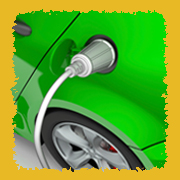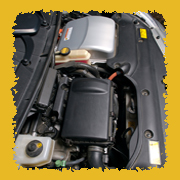Tell Me More Electrical Safety-SMART! Home
Electric Vehicles
Electric vehicles (EVs) run on electrical energy instead of—or in addition to—gasoline. Industry experts anticipate there will be over a million EVs on the roads this decade. They are popular for many reasons:
- EVs help reduce pollution.
- EVs cost less to run than gasoline vehicles.
- EVs reduce our dependency on gasoline.
Battery Electric Vehicles
Battery EVs run entirely on electrical energy. Instead of a fuel tank, batteries store the electricity that is used to operate an EV. These batteries can be charged by plugging the vehicle into a charging station or a 220 V outlet at a home or an office. The batteries store the electricity until the vehicle is driven.
Early types of battery EVs included golf carts, scooters, and other vehicles used for short trips at low speeds. With rapid industry growth this decade, there are now many types of battery EVs on the roads to accommodate both city and highway driving needs. City EVs can travel 40-65 mph and go a bit over 50 miles on a charge. Highway EVs can travel about 80 mph, and clock roughly 75-100 miles on a charge.
Under the hood, an EV consists of an electric motor, one or more controllers, and batteries. The controller governs the amount of electricity that flows from the batteries to the motor when the driver steps on the accelerator. The motor changes electrical energy from the batteries to mechanical energy, which makes the vehicle move.
Extended Range Electric Vehicles (EREV) are powered by an on-board battery and either a small motor engine or other secondary source connected to a generator to resupply the batteries and allow extended driving when the batteries become low. An example of an EREV is the Chevrolet Volt.
Driving an EV down the road produces no pollution at all. Even when pollution related to power plant electricity production is factored in, EVs produce less pollution than gasoline or diesel vehicles. EVs are also twice as efficient as gasoline or diesel vehicles, if you compare the energy used in creating gasoline at a refinery to producing electricity in a power plant.
When an EV is stopped in traffic, it doesn't have to use fuel to keep the motor running like a gasoline engine does. Added efficiency is created by something called "regenerative braking." When an EV slows down, the motor continues to turn, but the power no longer flows to the wheels. Instead, the power is fed back to the batteries, giving them a small charge every time the driver stops or goes downhill.
Hybrid Electric Vehicles
A hybrid electric vehicle uses two or more power sources, the most common being the gasoline-electric hybrids, also called hybrid EVs. Most hybrid EVs run on both a gasoline engine and an electric motor. They are similar in size and comfort level to the most popular gasoline-powered vehicles.
The major components of a hybrid EV include a gasoline engine, an electric motor, a transmission, and, in some models, a generator. A fuel tank stores gasoline for the engine, and a battery pack stores electricity for the motor. The battery is charged by the gasoline engine and by the electric motor or generator during normal operation. Regenerative braking charges the batteries slightly when the car slows down, recovering some of the energy that's usually lost when brakes are applied. The transmission moves, or transmits, mechanical energy from the engine or motor to the vehicle's wheels.
Another type of Hybrid Electric Vehicle is the Plug-in Hybrid Electric Vehicle (PHEV), which uses both a gasoline engine and electricity obtained by plugging into the electrical grid. The PHEV battery can be recharged by either the gas engine, or by electricity.
Both types of hybrid EVs use smaller, more efficient gasoline engines than conventional gasoline or diesel vehicles. They also produce less tailpipe emissions and provide much better gas mileage. Burning less fuel means producing fewer pollutants. Hybrid EVs also release less carbon dioxide into the air. Carbon dioxide is a greenhouse gas that contributes to climate change.









